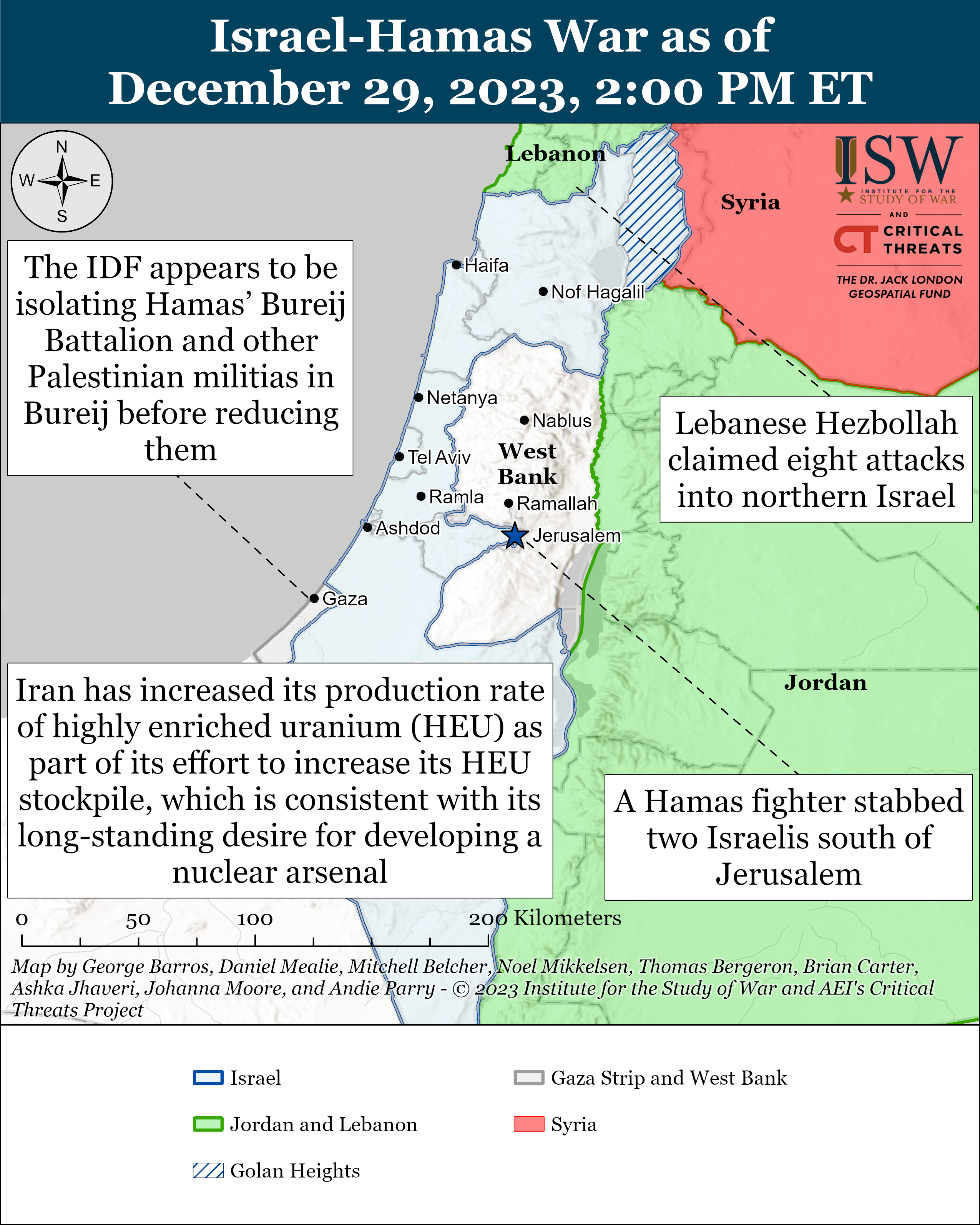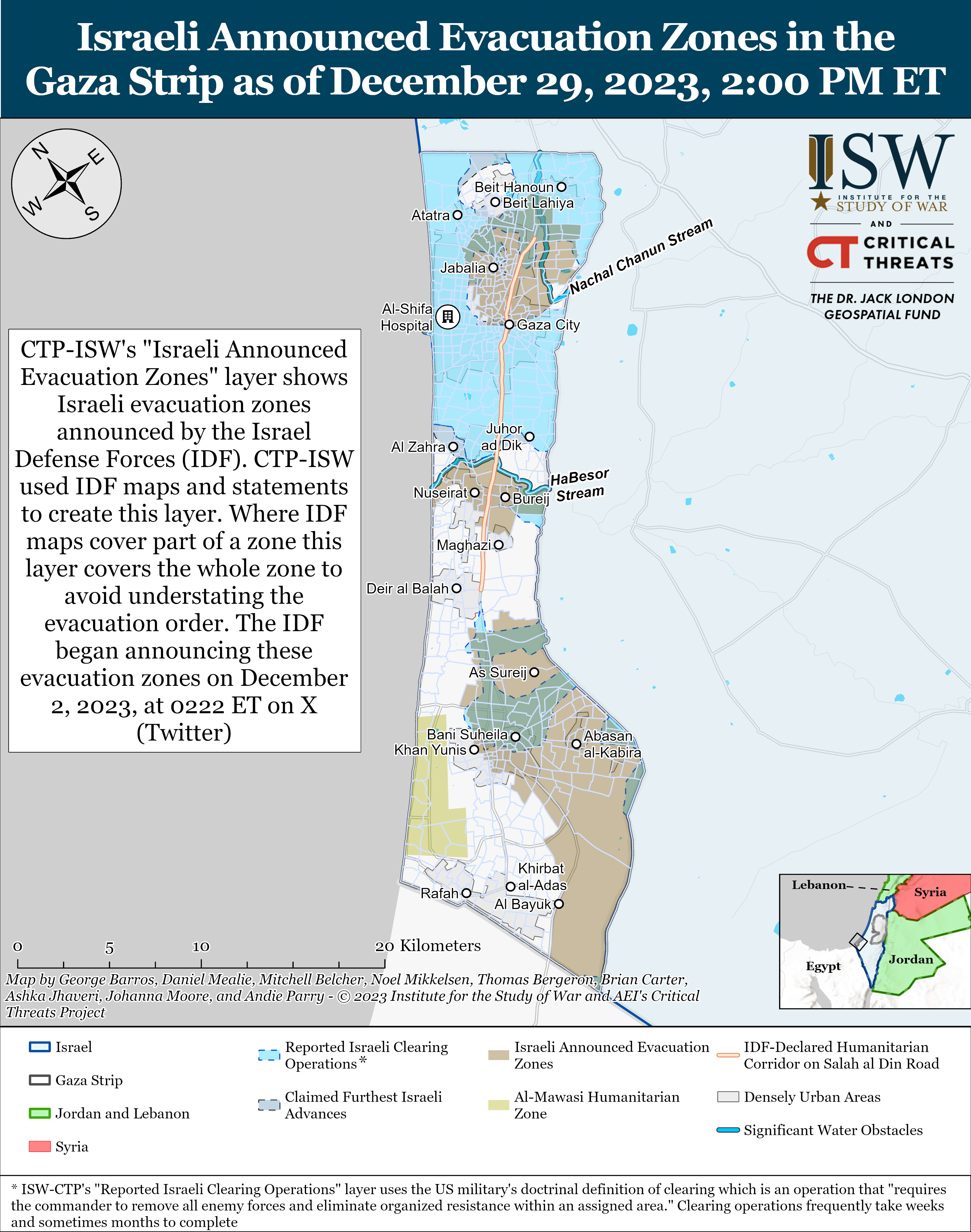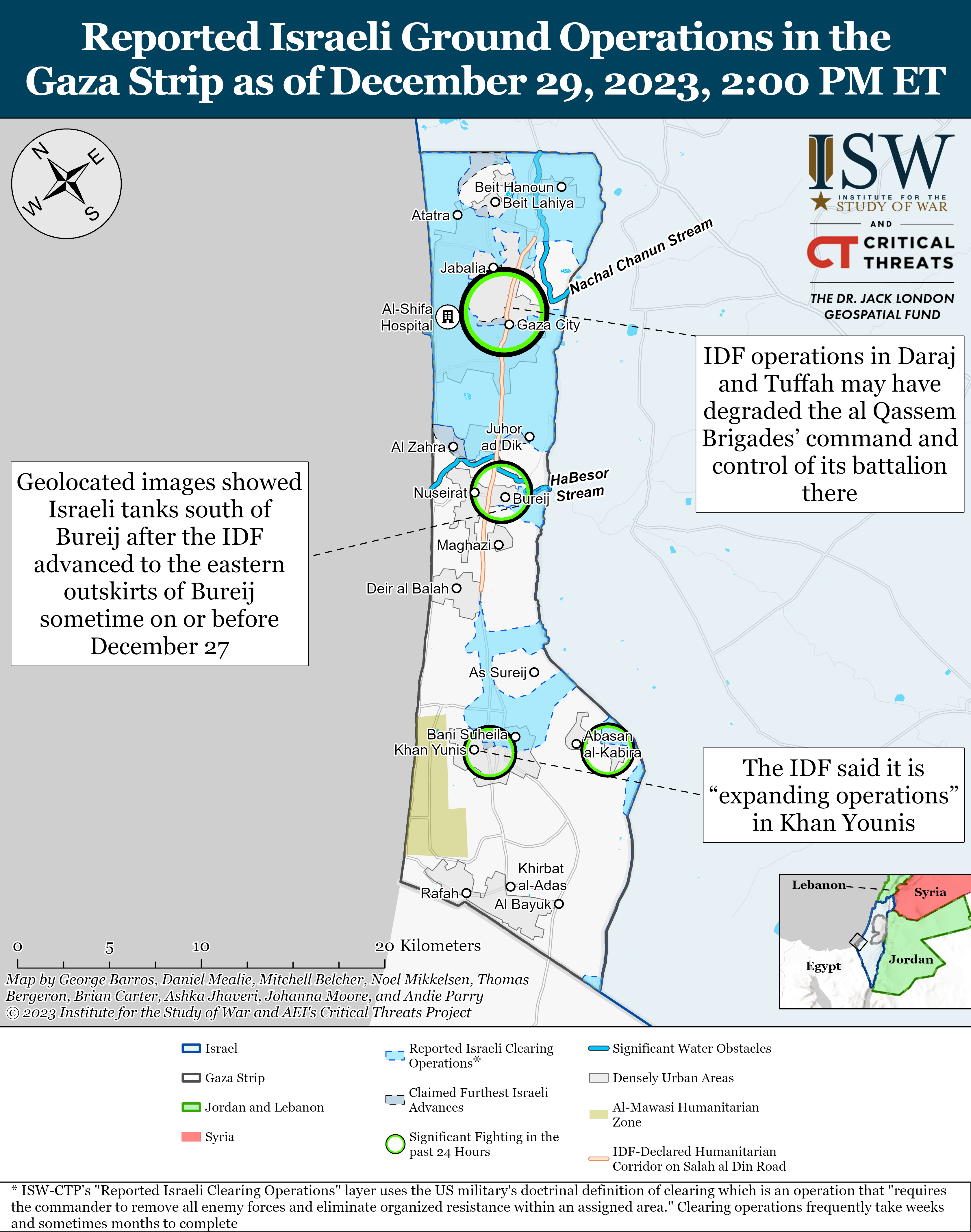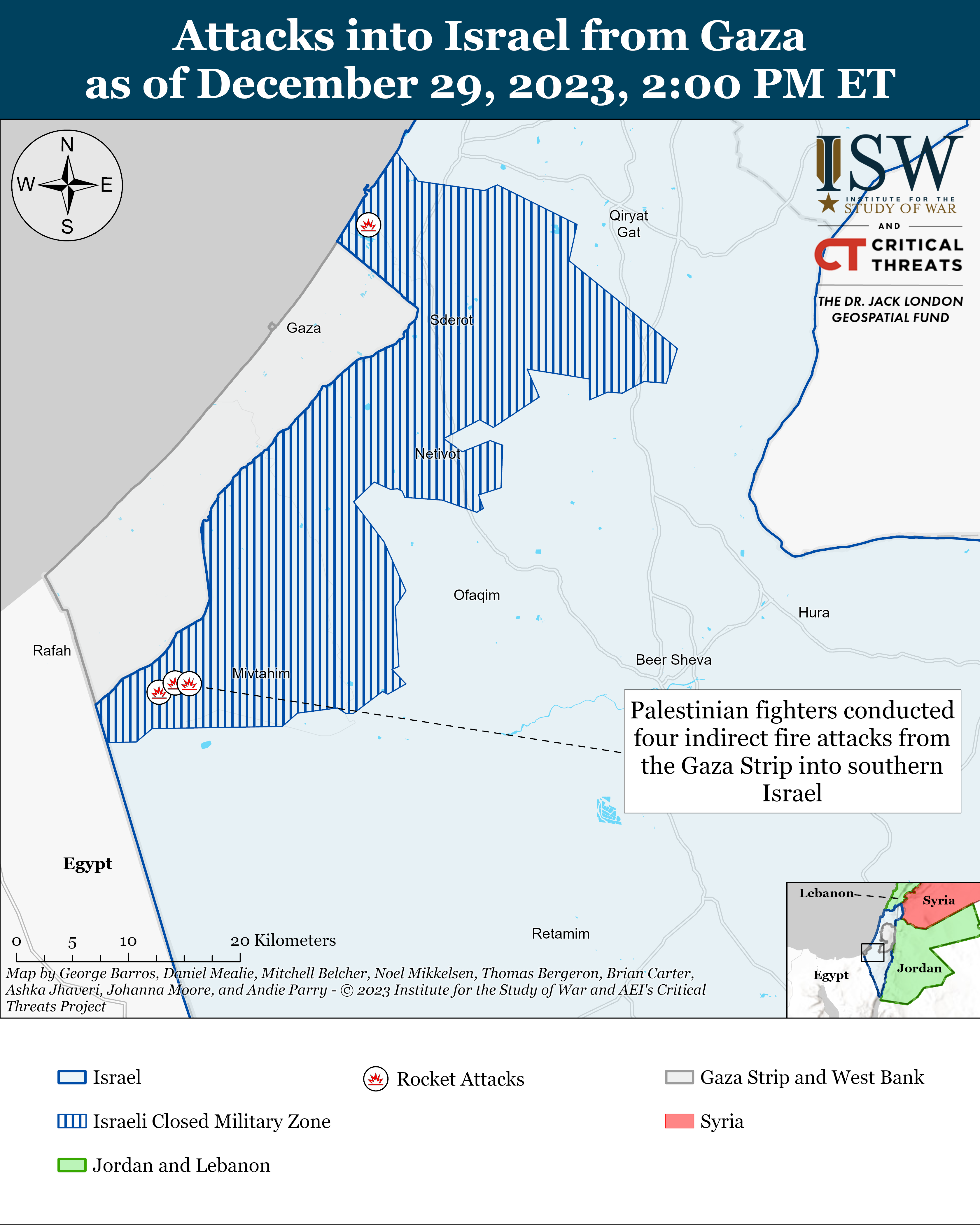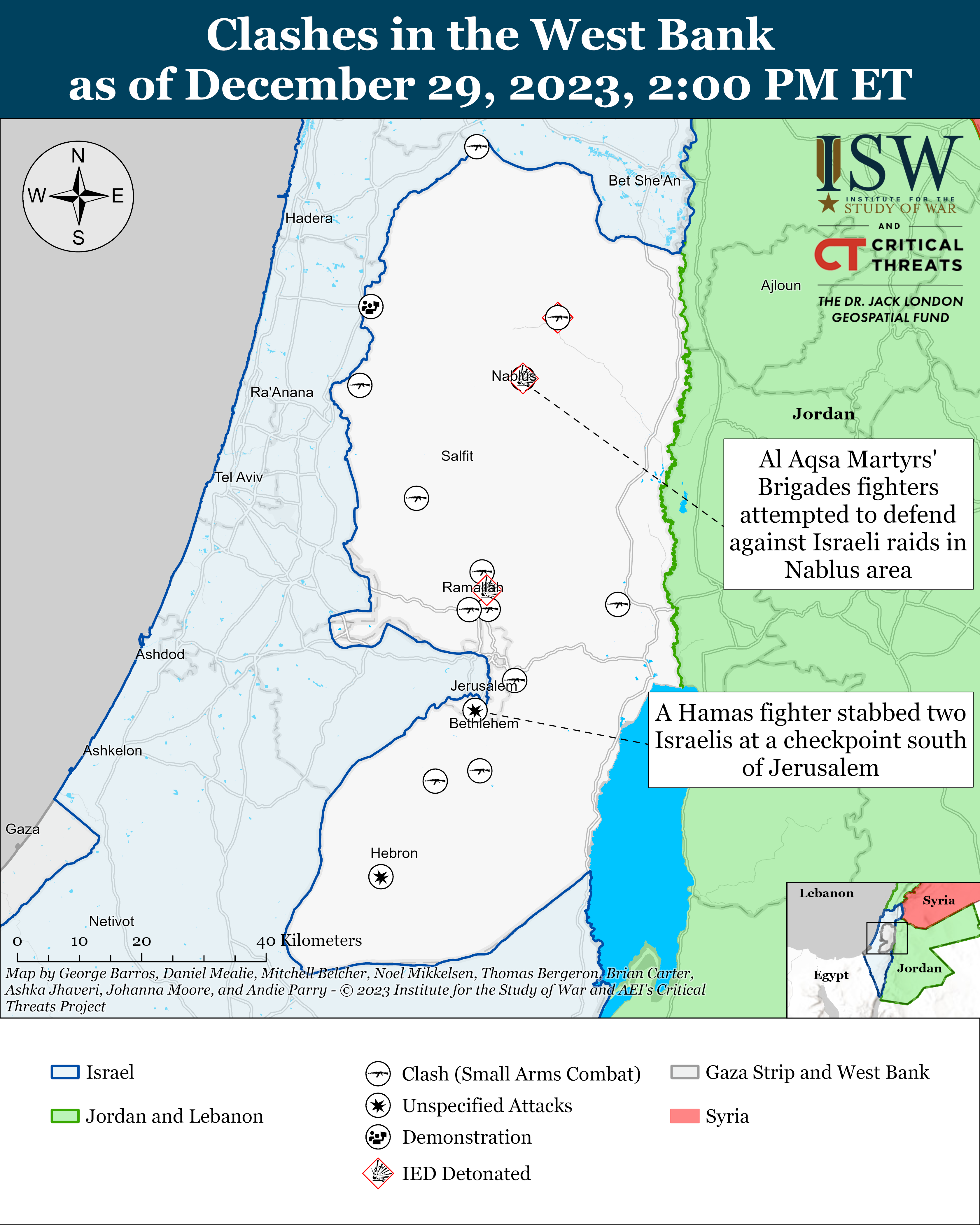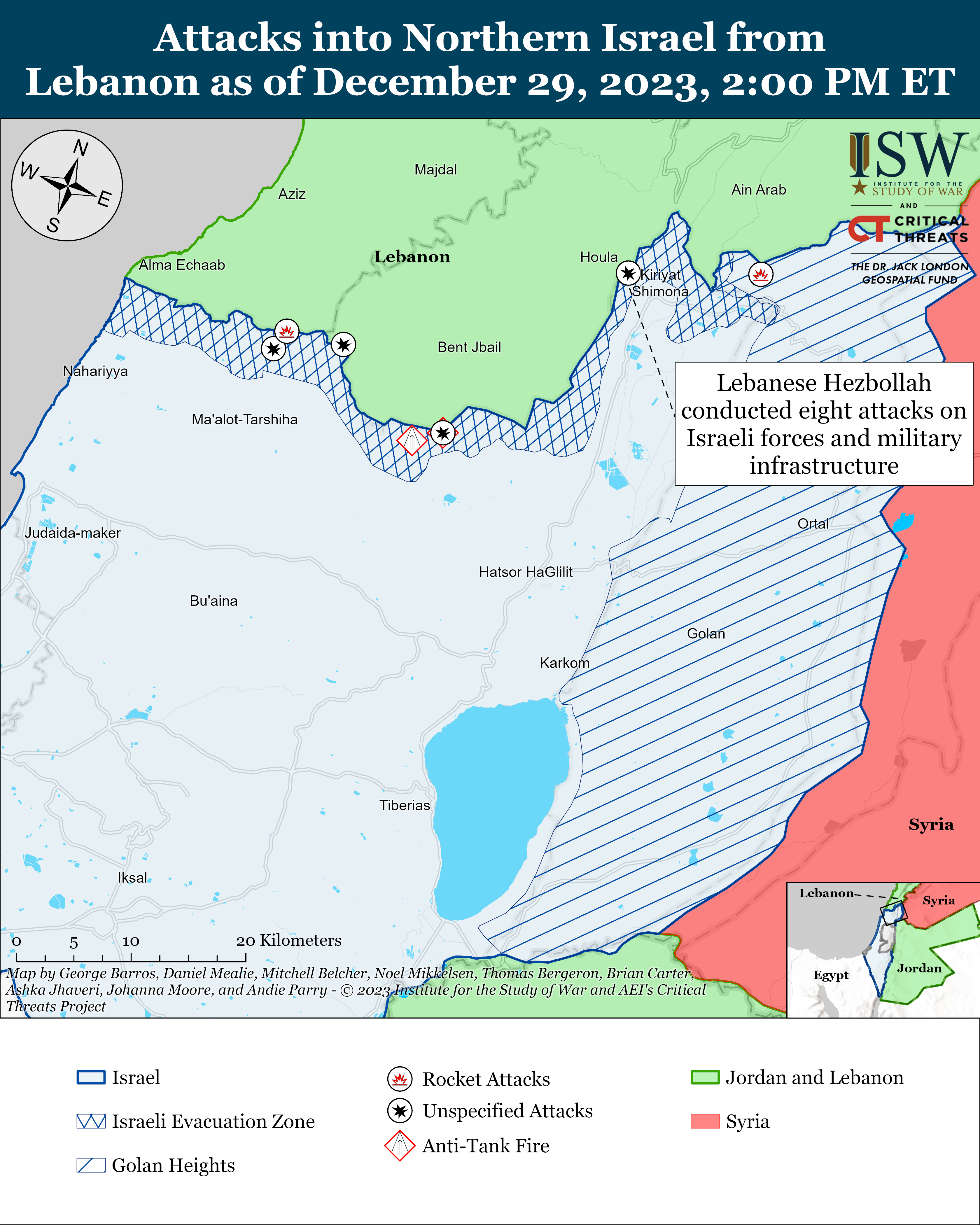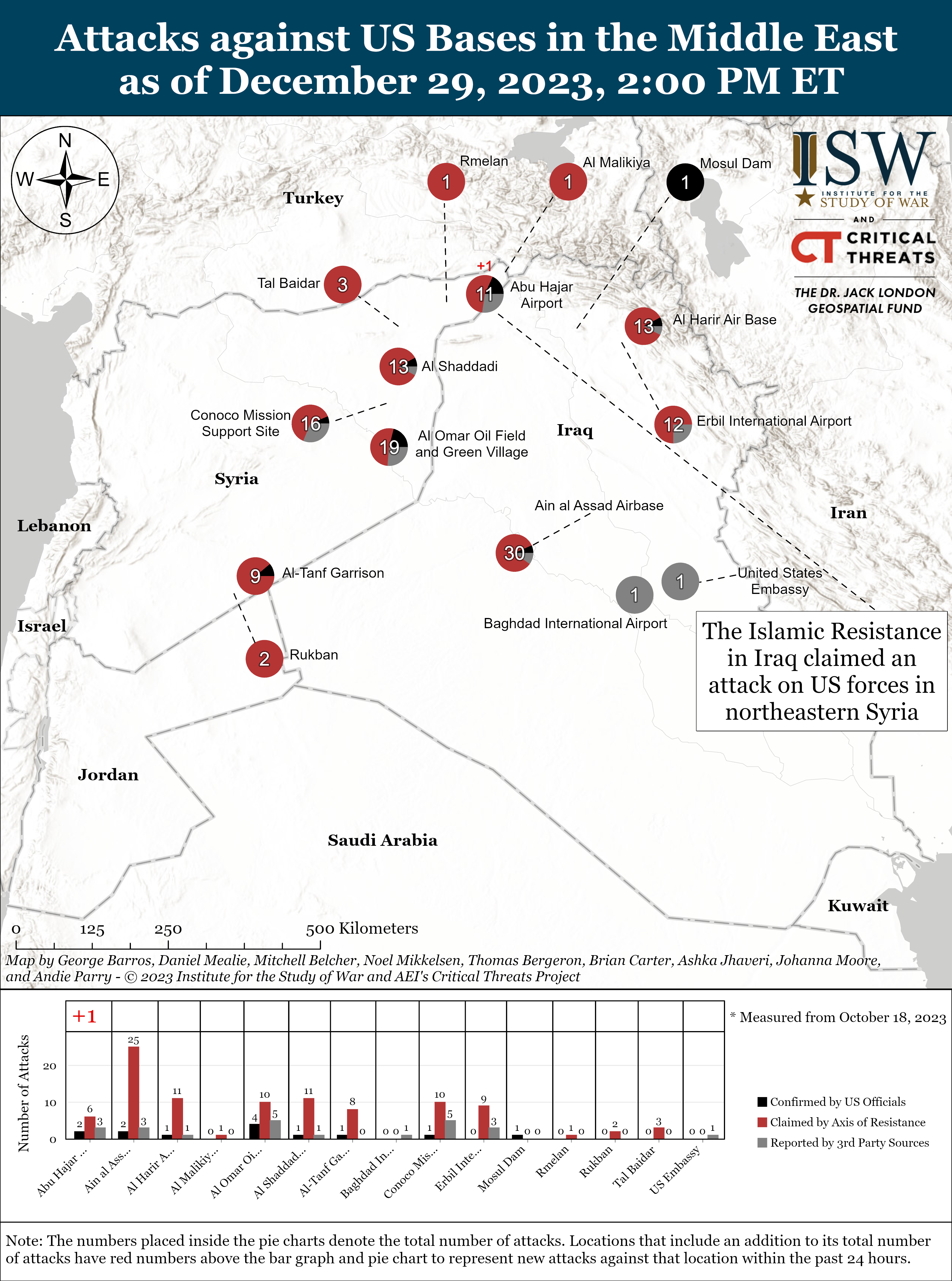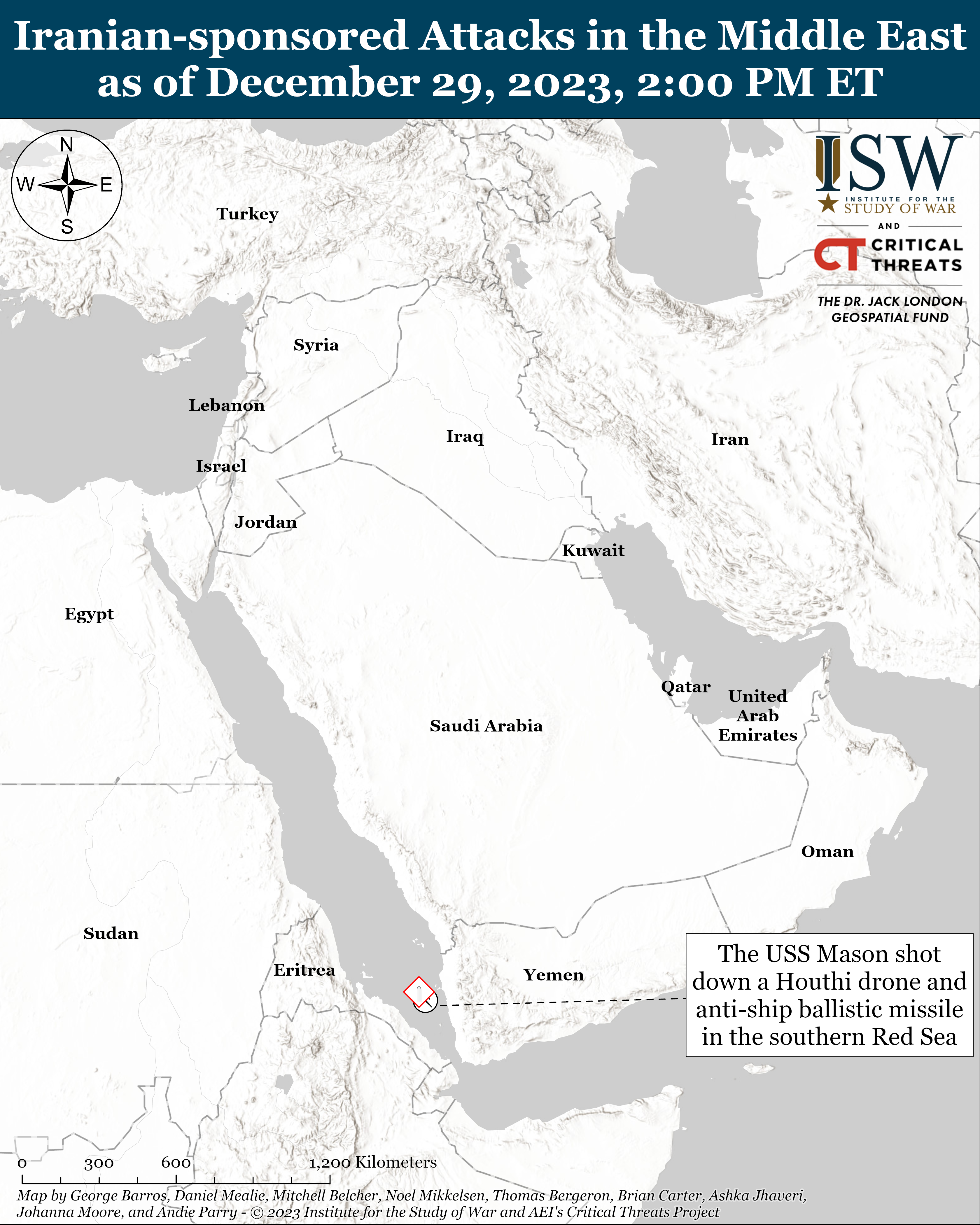Iran Update, December 29, 2023
Andie Parry, Amin Soltani, Brian Carter, and Alexandra Braverman
Information Cutoff: 2:00 pm EST
The Iran Update provides insights into Iranian and Iranian-sponsored activities abroad that undermine regional stability and threaten US forces and interests. It also covers events and trends that affect the stability and decision-making of the Iranian regime. The Critical Threats Project (CTP) at the American Enterprise Institute and the Institute for the Study of War (ISW) provides these updates regularly based on regional events. For more on developments in Iran and the region, see our interactive map of Iran and the Middle East.
Note: CTP and ISW have refocused the update to cover the Israel-Hamas war. The new sections address developments in the Gaza Strip, the West Bank, Lebanon, and Syria, as well as noteworthy activity from Iran’s Axis of Resistance. We do not report in detail on war crimes because these activities are well-covered in Western media and do not directly affect the military operations we are assessing and forecasting. We utterly condemn violations of the laws of armed conflict and the Geneva Conventions and crimes against humanity even though we do not describe them in these reports.
Click here to see CTP and ISW’s interactive map of Israeli ground operations. This map is updated daily alongside the static maps present in this report.
Key Takeaways:
- Iran has increased its production rate of highly enriched uranium (HEU). This development is consistent with CTP-ISW’s long-standing assessment that Iran has developed a nuclear program that it intends to use to produce a nuclear arsenal.
- IDF operations in Daraj and Tuffah may have degraded the al Qassem Brigades’ command and control of its battalion there.
- The IDF continued clearing operations near Khuzaa, east of Khan Younis, on December 29. The IDF also said that it is “expanding operations” in Khan Younis.
- Khan Younis Brigade commander Mohammed Sinwar may be increasing his power within Hamas’ military wing at the expense of Mohammed Deif.
- Israeli aircraft conducted two airstrikes targeting Damascus International Airport and air defense systems in southern Syria to interdict Iranian weapons shipments to Lebanese Hezbollah on December 28.
- Two key Iranian proxies in Iraq called for the expulsion of US forces from Iraq on December 29.
- The US Treasury Department sanctioned a Turkish and Yemeni financial network that enabled the IRGC Quds Force to fund the Houthis.
Iran has increased its production rate of highly enriched uranium (HEU). The United States and the E3 confirmed in a joint statement on December 28 that Iran has increased its enrichment rate of 60 percent purity uranium.[1] Iran has been stockpiling 60 percent HEU since April 2021.[2] Iran decreased its enrichment rate and HEU stockpile after it reached an informal nuclear agreement with the United States in August 2023.[3] Western media reported that the United States refroze Iranian financial assets released as part of the agreement in October.[4] Iran’s current stockpile of 60 percent HEU stands at 128.3 kilograms as of October 28.[5]
This development is consistent with CTP-ISW’s long-standing assessment that Iran has developed a nuclear program that it intends to use to produce a nuclear arsenal.[6] The International Atomic Energy Agency (IAEA) defines 25 kilograms of 20 percent or more enriched HEU as a “significant quantity” for “which the possibility of manufacturing a nuclear explosive device cannot be excluded.”[7] Iran has stockpiled at least five bombs worth of HEU, given Iran’s current stockpile of 128.3 kilograms of 60 percent HEU. Iran previously planned to serially produce nuclear warheads for ballistic and cruise missiles as part of its pre-2003 nuclear weapons program[8] The stockpiling of HEU is one of the key steps Iran would have to pursue to develop an arsenal and has previously conducted work on the other key steps in weaponization and delivery vehicles.[9] The Iranian enrichment infrastructure is also designed for a speedy mass production of HEU and/or weapons-grade uranium for multiple nuclear weapons.[10]
Iran has no use for 60 percent HEU other than for use in a compact nuclear explosive or to further enrich it to 90 percent weapons-grade uranium. Sixty percent HEU can only be used for nuclear weapons and does not have an alternate civilian purpose. The required enriched uranium purity for energy purposes is between 3 to 5 percent, and medical research reactors use 20 percent HEU.[11] Iran is now capable of producing weapons-grade uranium at a much faster rate than it would be if it only had a stockpile of lower than 60 percent enriched uranium.
Gaza Strip
Axis of Resistance campaign objectives:
- Erode the will of the Israeli political establishment and public to launch and sustain a major ground operation into the Gaza Strip
- Degrade IDF material and morale around the Gaza Strip.
The IDF appears to be isolating Hamas’ Bureij Battalion and other Palestinian militias in Bureij before reducing them.[12] Geolocated images posted on December 28 showed Israeli tanks south of Bureij after the IDF advanced to the eastern outskirts of Bureij sometime on or before December 27.[13] Israeli forces have also cleared areas north of Bureij near Mughraqa.[14] Israeli forces have not yet advanced to the western side of Bureij, which would isolate the town. The IDF reported on December 28 that its operation in Bureij was in its “final stages.”[15]
Palestinian fighters attempted to defend against the IDF’s advance on December 29. Hamas’ military wing, the al Qassem Brigades, detonated a “minefield” targeting Israeli forces north of Bureij on December 29.[16] The al Qassem Brigades and other Palestinian militias fired small arms and anti-fortification rockets targeting Israeli forces north and east of the town.[17]
IDF operations in Daraj and Tuffah may have degraded the al Qassem Brigades’ command and control of its battalion there. Hamas’ al Qassem Brigades claimed on December 29 that they targeted twenty vehicles over 48 hours in Daraj and Tuffah.[18] Hamas’ military wing usually claims individual attacks targeting Israeli forces. Hamas’ inability to publish individual claims suggests that it lacks reliable communication with individual Hamas units in Daraj and Tuffah. Poor communications also inhibit the command and control of various units. Intense IDF clearing operations reduce communications capabilities by targeting infrastructure and killing individual fighters responsible for communicating with higher headquarters.[19] Hamas and PIJ have also said previously that it has “lost contact” with specific units for short periods in this area.[20] Hamas did not indicate that it lost communication with any forces in Daraj and Tuffah between December 27 and 29.
The IDF said that it is “expanding operations” in Khan Younis on December 29.[21] The IDF did not specify how it was “expanding operations” in Khan Younis. IDF units have operated in and around Khan Younis since December 2. The IDF said on December 29 that the 7th Armored Brigade Combat Team (BCT) and the 900th BCT both continued clearing operations in Khan Younis.[22] The 900th BCT found weapons and IED caches and booby-trapped tunnels that Palestinian fighters had prepared to use for ambushes.[23] The 7th BCT called in close air support to kill a Hamas cell hiding inside a building in Khan Younis.[24]
Palestinian fighters attempted to defend against Israeli advances in Khan Younis on December 29. Hamas’ military wing, the al Qassem brigades, used mortars and anti-tank rockets against advancing Israeli armor and infantry.[25] Fatah’s military wing, the al Aqsa Martyrs’ Brigade, clashed with an Israeli infantry squad east of Khan Younis.[26]
The IDF continued clearing operations near Khuzaa, east of Khan Younis, on December 29. The 5th BCT continued clearing operations in Khuzaa on December 29, where it captured anti-tank positions, tunnel shafts, and tunnel routes.[27] PIJ’s military wing, the al Quds Brigades, mortared Israeli forces in Abasan, near Khuzaa, on December 29.[28]
Hamas denied on December 29 that its officials will travel to Egypt after the Wall Street Journal reported that a Hamas political delegation would travel to Cairo to discuss Egypt’s ceasefire proposal.[29] Senior Hamas official Mahmoud Mardawi denied that Hamas officials would travel to Cairo on December 29 for talks with Egypt on a ceasefire agreement.[30] Mardawi and senior Hamas official and former Gazan Health Minister Bassem Naim reiterated Hamas’ negotiating position in separate statements, saying that Hamas would not negotiate or exchange prisoners without an end to the Israeli ground operation.[31] These comments are consistent with CTP-ISW’s assessment that both Hamas’ political leader in Gaza Yahya Sinwar and Hamas’ external political leaders seek to use their Israeli hostages as leverage to maintain their influence in negotiations.[32]
PIJ Deputy Secretary General Mohammed al Hindi said that PIJ seeks to create a “unified Palestinian response” to the Egyptian proposal.[33] This is consistent with CTP-ISW’s December 28 assessment that Hamas and its Palestinian allies are using multiple, overlapping negotiations with different external parties to embed themselves in a postwar “unity government.”[34] Hindi claimed that Israel wants to continue its operations after it returns the hostages, which would leave Hamas and PIJ no more leverage with Israel.[35]
Khan Younis Brigade commander Mohammed Sinwar may be increasing his power within Hamas’ military wing at the expense of Mohammed Deif. A veteran French Middle East correspondent reported on December 26 that Mohammed Sinwar had taken over day-to-day control of Hamas’ military wing, the al Qassem Brigades, from Mohammed Deif.[36] The report claimed that while Deif still exerted influence and smoothed over internal differences, Mohammed Sinwar controlled the organization.[37] This report is consistent with the IDF’s bounty on Sinwar, which is 200,000 USD greater than the bounty on Deif.[38]
The greater bounty on Sinwar could also reflect Sinwar’s greater influence within the organization as the IDF gradually degrades and then defeats al Qassem Brigades units elsewhere in the strip.[39] Mohammed Sinwar is the Khan Younis Brigade commander, and Israeli sources call his brigade “strong and well-trained.”[40] IDF military operations degraded the Northern and Gaza City Brigades—which were the strongest Hamas brigades before the war—between the beginning of the ground operation and December 29.[41]
An Israeli journalist reported on December 28 that US President Joe Biden and Israeli Prime Minister Benjamin Netanyahu discussed Israeli payments to the Palestinian Authority (PA) on December 24.[42] Israel collects tax revenues for the PA, which Israel has withheld since the October 7 attacks. The tax revenue covers expenses in both the Gaza Strip and the West Bank. Israel has offered to release the West Bank taxes to the PA but refused to release the Gaza Strip taxes, noting that Hamas controls the Gaza Strip and those tax revenues would benefit Hamas. The PA refused to accept the West Bank taxes without the Gaza Strip taxes. The United States proposed that the Israelis send all the tax revenues to Norway, which would then hold the revenues for the Gaza Strip until the Israelis and PA could negotiate a deal for the release of the Gaza Strip revenues. Norway would send the funds for the West Bank to the PA. Israel has not agreed to send the revenues to Norway. Netanyahu told Biden that he did not trust Norway, according to a US official and a “source with knowledge of the call.”
Palestinian fighters conducted four indirect fire attacks from the Gaza Strip into southern Israel on December 29. The al Quds Brigades claimed three rocket attacks targeting southern Israel on December 29.[43] Unspecified fighters also fired one rocket salvo targeting Zikim.[44]
Recorded reports of rocket attacks; CTP-ISW cannot independently verify impact.
West Bank
Axis of Resistance campaign objectives:
- Draw IDF assets and resources toward the West Bank and fix them there
Israeli forces clashed with Palestinian fighters in 13 locations across the West Bank on December 29.[45] The Nablus Battalion of the al Aqsa Martyrs’ Brigade attempted to defend against Israeli raids in Balata and Faraa camps. The group fired small arms and detonated IEDs targeting Israeli vehicles and infantry.[46] Israeli forces arrested 12 people, including two Hamas fighters, and confiscated weapons in West Bank raids on December 29.[47]
Two Palestinian fighters conducted two separate attacks on Israeli checkpoints east of Bethlehem and in Hebron.[48] Hamas claimed the Bethlehem attacker and called for Palestinians to conduct further attacks on Israelis.[49] PIJ celebrated the two terror attacks.[50]
Palestinians held a single demonstration in Tulkarm on December 29, despite calls from Hamas for demonstrations on December 29 across the West Bank and Israel.[51] Hamas had called for Friday demonstrations since December 26.[52]
This map is not an exhaustive depiction of clashes and demonstrations in the West Bank.
Southern Lebanon and Golan Heights
Axis of Resistance campaign objectives:
- Draw IDF assets and resources toward northern Israel and fix them there
- Set conditions for successive campaigns into northern Israel
Lebanese Hezbollah (LH) conducted eight attacks from southern Lebanon into northern Israel on December 29.[53] LH targeted Israeli military infrastructure, artillery, and soldiers with anti-tank guided munitions, rockets, and other unspecified weapons.[54] PIJ mourned two fighters who died in southern Lebanon on December 29.[55] The PIJ fighters’ deaths underscore the role that other Iranian-backed militias play in attacking Israel from southern Lebanon.
LH leaders signaled on December 29 that they are not deterred by Israeli “threats” to invade Lebanon. LH Executive Council Deputy Chairman Ali Damoush stated that LH will continue operations against northern Israel until Israel withdraws from the Gaza Strip regardless of the pressures, threats, and sacrifices.[56] Damoush also celebrated that LH’s attacks are creating internal divisions in Israel. Senior Israeli military and political officials have repeatedly signaled that Israel seeks to push LH north of the Litani River using diplomatic measures in accordance with UNSCR 1701.[57] Israeli officials have noted, however, that if diplomacy fails, Israel will resort to military force.[58]
Israeli aircraft conducted two airstrikes targeting Damascus International Airport and air defense systems in southern Syria to interdict Iranian weapons shipments to Lebanese Hezbollah on December 28.[59] An anti-regime reporter said that the airstrike put the runway out of service a day after the Syrian regime reopened it after repairing damage from a previous Israeli airstrike.[60] Israel frequently destroyed Syrian airport runways at the start of the Israel-Hamas war, often bombing the runway hours after the completion of repairs.[61] Israel has conducted previous strikes at the Damascus International Airport to prevent Iranian weapons deliveries.[62]
Israeli media reported on December 29 that Israeli airstrikes on Damascus International Airport”in recent days” intended to thwart weapons ransfers from Iran to Lebanese Hezbollah.[63] This supports CTP-ISW’s previous assessments that Israeli airstrikes on Damascus International Airport disrupt a transportation node through which the IRGC has historically tried to transfer military materiel and personnel to Syria and Lebanon.[64] Ynet reported on December 29 that Iran is accelerating weapons transfers to LH in anticipation of a wider war with Israel.[65] The outlet said that Iran is sending precision-guided missiles, anti-tank missiles, and surface-to-air missiles to LH mostly via the Damascus International Airport.[66] An Israeli airstrike in Damascus killed an IRGC brigadier general who was responsible for managing Iranian weapons shipments to LH and Iranian-backed militias in Syria on December 25.[67]
Iran and Axis of Resistance
Axis of Resistance campaign objectives:
- Demonstrate the capability and willingness of Iran and the Axis of Resistance to escalate against the United States and Israel on multiple fronts
- Set conditions to fight a regional war on multiple fronts
Two key Iranian proxies in Iraq called for the expulsion of US forces from Iraq on December 29. These are the twelfth and thirteenth statements by top Iranian-backed political leaders, Iranian-backed Iraqi government officials, and major Iranian-backed Iraqi armed groups calling for the expulsion of US forces from Iraq since December 5.[68] Smaller front groups for major Iranian-backed Iraqi armed groups have called for the expulsion of US forces from Iraq twice since December 5.[69]
Key Iranian proxy and Badr Organization head Hadi al Ameri called on the Iraqi government to set a timetable to end the US presence in Iraq.[70] Ameri claimed that the Iraqi Security Forces (ISF) can maintain security in Iraq. The US mission in Iraq continues to provide logistics, intelligence, and fire support to the ISF.[71] Corruption and mismanagement within the ISF after the US withdrawal in 2011 contributed to the ISF’s rapid collapse during the ISIS offensive against Mosul and northern Iraq in 2014.[72]
Key Iranian proxy and Popular Mobilization Forces chief Faleh al Fayyadh said that Iraqi sovereignty is only disturbed by the “abnormal presence that we are working to end” on December 29.[73] The United States sanctioned Fayyadh in 2021 for serious human rights abuses during Iraq’s 2019 protest movement, when he worked with then-IRGC-Quds Force commander Qassem Soleimani and US-designated terrorist Qais al Khazali to kill hundreds of Iraqi protesters.[74]
The Islamic Resistance in Iraq—a coalition of Iranian-backed Iraqi militias—claimed responsibility for a rocket attack targeting US forces at Rumaylan Landing Zone in northeastern Syria on December 29.[75]
The Houthi movement continued its anti-shipping attack campaign on December 28. CENTCOM said that the USS Mason shot down one drone and one anti-ship ballistic missile in the southern Red Sea that the Houthis had fired.[76] The drone and missile did not cause damage to any of the 18 nearby vessels. The Houthis did not claim responsibility for the attack.
The US Treasury Department sanctioned a Turkish and Yemeni financial network that enabled the IRGC Quds Force to fund the Houthis.[77] The US sanctions targeted one Yemeni, one Turkish entity, two Yemeni entities, and one Turkish entity responsible for facilitating financial flows between the IRGC Quds Forces and the Houthi movement. The Treasury Department said that Iranian funding enables Houthi attacks against international shipping in the Red Sea. The sanctions targeted Turkey-based Al Aman Kargo Ithalat Ihracat Ve Nakliyat Limited Sirketi (Al Aman), which Treasury said served as ”a waypoint for money sent by” Iran to Houthi businesses in Yemen. The sanctions also targeted two Yemeni money exchanges tied to the Houthis and one Yemeni national, the president of the Yemeni Currency Exchangers Association in Houthi-controlled Sanaa, Yemen.[78]
Iran hanged four individuals in West Azerbaijan province over alleged ties to the Israeli Mossad on December 29.[79] Iranian media said that the alleged Mossad spies planned to kidnap and interrogate members of Iranian security forces.[80] Iran sentenced six additional individuals to ten years in jail for allegedly communicating with Israel with intent to disrupt Iranian security.[81]
Former Israeli Prime Minister Naftali Bennett took credit for two operations that occurred in 2022 against Iran in a Wall Street Journal op-ed on December 28.[82] Bennett said that Israel destroyed a UAV base on Iranian soil in response to attacks against Israel. Bennett said that he also ordered the assassination of an IRGC commander who was responsible for targeting Israeli tourists in Turkey in March 2022.[83]
[12] The US military defines “isolate” as a tactical mission task that requires a unit to seal off—both
physically and psychologically—an enemy from sources of support, deny the enemy freedom of movement, and prevent the isolated enemy force from having contact with other enemy forces.” The US military defines “reduce” as “a tactical mission task that involves the destruction of an encircled
or bypassed enemy force.” See more: https://irp.fas.org/doddir/army/fm3-90-1.pdf
[30] https://www.almayadeen dot net/latestnews/2023/12/29/%D8%A7%D9%84%D9%82%D9%8A%D8%A7%D8%AF%D9%8A-%D9%81%D9%8A-%D8%AD%D8%B1%D9%83%D8%A9-%D8%AD%D9%85%D8%A7%D8%B3-%D9%85%D8%AD%D9%85%D9%88%D8%AF-%D8%A7%D9%84%D9%85%D8%B1%D8%AF%D8%A7%D9%88%D9%8A-%D9%84%D9%84%D9%85%D9%8A%D8%A7%D8%AF%D9%8A%D9%86–%D9%84%D8%A7-%D9%88%D9%81%D8%AF-%D9%85%D9%86-%D8%AD%D9%85%D8%A7%D8%B3
[31] https://www.almayadeen dot net/latestnews/2023/12/29/%D8%A7%D9%84%D9%82%D9%8A%D8%A7%D8%AF%D9%8A-%D9%81%D9%8A-%D8%AD%D8%B1%D9%83%D8%A9-%D8%AD%D9%85%D8%A7%D8%B3-%D9%85%D8%AD%D9%85%D9%88%D8%AF-%D8%A7%D9%84%D9%85%D8%B1%D8%AF%D8%A7%D9%88%D9%8A-%D9%84%D9%84%D9%85%D9%8A%D8%A7%D8%AF%D9%8A%D9%86–%D9%84%D8%A7-%D9%88%D9%81%D8%AF-%D9%85%D9%86-%D8%AD%D9%85%D8%A7%D8%B3; https://t.me/hamasps/18726
[69] https://t.me/aishab_alkahf/136; https://www.shafaq dot com/ar/%D8%B3%DB%8C%D8%A7%D8%B3%D8%A9/%D8%A7%D9%84%D8%B9%D8%A7%D9%85%D8%B1%D9%8A-%D9%84%D8%A7-%D9%86%D8%AD%D8%AA%D8%A7%D8%AC-%D9%84%D9%82%D9%88%D8%A7%D8%AA-%D8%A7%D9%84%D8%AA%D8%AD%D8%A7%D9%84%D9%81-%D8%A7%D9%84%D8%AF%D9%88%D9%84%D9%8A-%D9%81%D9%8A-%D8%A7%D9%84%D8%B9%D8%B1%D8%A7%D9%82-%D9%88%D9%8A%D8%AC%D8%A8-%D8%A7%D9%86-%D9%8A%D8%AE%D8%B1%D8%AC%D9%88%D8%A7-%D9%81%D9%88%D8%B1%D8%A7; https://www.shafaq dot com/ar/%D8%B3%DB%8C%D8%A7%D8%B3%D8%A9/%D9%81%D8%B5%D9%8A%D9%84-%D8%B9%D8%B1%D8%A7%D9%82%D9%8A-%D9%8A%D8%B1%D9%81%D8%B6-%D8%A7%D8%B3%D8%AA%D9%87%D8%AF%D8%A7%D9%81-%D8%A7%D9%84%D8%A8%D8%B9%D8%AB%D8%A7%D8%AA-%D8%A7%D9%84%D8%AF%D8%A8%D9%84%D9%88%D9%85%D8%A7%D8%B3%D9%8A%D8%A9-%D9%88%D9%8A%D8%AF%D8%B9%D9%88-%D8%A7%D9%84%D8%AD%D9%83%D9%88%D9%85%D8%A9-%D8%A8-%D9%84-%D8%AA%D9%83%D9%88%D9%86-%D8%B7%D8%B1%D9%81%D8%A7-%D8%A8%D8%A7%D9%84%D8%B5%D8%B1%D8%A7%D8%B9-%D9%85%D8%B9-%D9%85%D8%B1%D9%8A%D9%83%D8%A7


